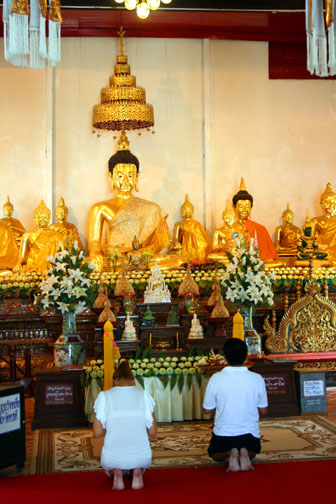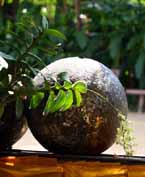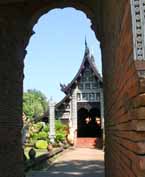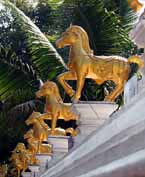Tags
Wat Duang Di is a small temple in Chiang Mai that few touri stumble upon. Just a block away from the Three Kings Monument it’s off the beaten path, even if that path, a small residential soi shaded by longan trees, is enticing in its simplicity leading away from the hectic pace of Phrapokklao Road. There’s a sign that alerts you to the wat’s existence, but even then it is one of those wats you have to be looking for to find. In a town filled with hundreds of wats, it’s an easy temple to overlook. And according to Google, easy to miss identify too. Half of the pictures returned by the search engine are not Wat Duang Di. And that ‘Multicolored Dragon Statue’ that Zazzle is so thrilled with? You won’t find it at Wat Duang Di either.
What you will find is a small wiharn, an ubosot, a chedi, and the temple’s ho trai, or scripture repository notable for its stucco decoration. The most striking feature is the front facade of the wiharn, which is richly carved and gilded. The inside of the temple is simple, decorated with rather crude murals, and even the main Buddha statue is not very imposing. But the wat is rich in history. It’s bot dates back to the beginning of the 16th century when the temple was called Wat Ton Mak Nua. And in 1761 a monk from the wat became the ruler of Chiang Mai for a brief period when the city was free, temporarily, from Burmese control.
As small and unassuming as the wat is, the obvious pride the surrounding community has for the temple is readily evident. It’s grounds are beautifully landscaped and well cared for, and on-going renovations to the buildings and monks’ residences attest to the neighborhood’s involvement in keeping the ancient structures in pristine condition. While I’ve never felt anything but welcomed at any wat I’ve visited in Thailand, seldom have I been treated as warmly as during my brief visit to Wat Duang Di. The locals and monks I met all went out of their way to greet me and, quite proudly, showed off areas of the temple that felt I needed to see. Perhaps part of that attitude was due to the wat not receiving many foreign visitors, but it was such a concerted effort on their part that I couldn’t help but enjoy their enthusiasm and friendliness. There are certainly more impressive temples in the immediate area, but none that can compete with the welcome you’ll get at Wat Duang Di.
The temple’s name means The Good Luck Monastery. I don’t know if that means worshipers go there to pray for luck or it speaks more to the temple’s history. I do know that by visiting the wat you’ll be lucky to have experienced the warmth of its people who will remind you of one of the things that makes Thailand such a special place and why it is called the Land of Smiles.
Related Posts You Might Enjoy:









I was there last night (5th December) (but I wasn’t looking for it specifically). There was a show in honour of the King’s birthday on at the Three Kings monument, and after it ended we noticed that there were khom loi being launched from the grounds of a local Wat, which turned out to be Duang Di. Like you say, nice people doing it for fun and handing the lanterns out to tourists for free. Got a few night shots of the chedi, and a chance for some monk shots too.
http://www.flickr.com/photos/wgcman/8248833826/in/set-72157632177655145
http://www.flickr.com/photos/wgcman/8248836038/in/set-72157632177655145
http://www.flickr.com/photos/wgcman/8247772277/in/set-72157632177655145
Nice photos ceejay, thanks for sharing them.
I think I need to revisit that wat at night, it’s beautiful!